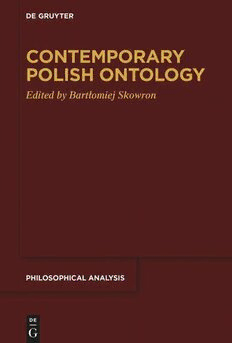
Contemporary Polish Ontology PDF
Preview Contemporary Polish Ontology
Contemporary Polish Ontology Philosophical Analysis Edited by Katherine Dormandy, Rafael Hüntelmann, Christian Kanzian, Uwe Meixner, Richard Schantz and Erwin Tegtmeier Volume 82 Contemporary Polish Ontology Edited by Bartłomiej Skowron ISBN 978-3-11-066932-9 e-ISBN (PDF) 978-3-11-066941-1 e-ISBN (EPUB) 978-3-11-066951-0 ISSN 2627-227X Library of Congress Control Number: 2019946358 Bibliographic information published by the Deutsche Nationalbibliothek The Deutsche Nationalbibliothek lists this publication in the Deutsche Nationalbibliografie; detailed bibliographic data are available on the Internet at http://dnb.dnb.de. © 2020 Walter de Gruyter GmbH, Berlin/Boston Printing and binding: CPI books GmbH, Leck www.degruyter.com Contents BartłomiejSkowron SomeIntroductoryThoughtsonContemporaryPolishOntology|VII TomaszBigaj OnEssentialStructuresandSymmetries|1 MariuszGrygianiec ProspectsforanAnimalisticallyOrientedSimpleView|25 FilipKobiela HowLongDoesthePresentLast?TheProblemofFissurationinRoman Ingarden’sOntology |51 ZbigniewKrólandJózefLubacz TheSubject’sFormsofKnowledgeandtheQuestionofBeing|71 AndrzejBiłat TheWorldasanObjectofFormalPhilosophy|87 UrszulaWybraniec-Skardowska LogicandtheOntologyofLanguage |109 KrzysztofŚleziński BenedictBornstein’sOntologicalElementsofReality|133 JanuszKaczmarek OntheTopologicalModellingofOntologicalObjects:Substanceinthe Monadology|149 KrzysztofWójtowicz DoesMathematicalPossibilityImplyExistence?|161 RafalUrbaniak NeologicismforReal(s)–AreWeThereYet?|181 VI | Contents JacekPaśniczek PossibleWorldsandSituations:HowCanTheyMeetUp?|205 MarekMagdziak TheOntologicofActions|219 MichałGłowala “PhysicalIntentionality”andtheThomisticTheoryofFormalObjects|245 BartłomiejSkowron,TomaszBigaj,ArkadiuszChrudzimski,MichałGłowala, ZbigniewKról,MarekKuś,JózefLubacz,andRafałUrbaniak AnAssessmentofContemporaryPolishOntology |271 AuthorIndex|295 BartłomiejSkowron Some Introductory Thoughts on Contemporary Polish Ontology This book is a collection of articles authored by Polish ontologists living and workingintheearlypartofthe21stcentury.Harkingbacktothewell-knownPolish Lvov-Warsaw School, founded by Kazimierz Twardowski,¹ we try to make our ontologicalconsiderationsassystematicallyrigorousandclearaspossible–i.e.to thegreatestextentfeasible,butalsonomorethanthesubjectunderconsideration itselfallowsfor.Hence,thepaperspresentedheredonotseektosteerclearof methodsofinquirytypicalofeithertheformalorthenaturalsciences:onthe contrary,theyusesuchmethodswhereverpossible.Atthesametime,Iwouldlike todrawattentiontothefactthatdespitetheiradherencetorigorousmethods,the Polishontologistsincludedheredonotavoidtraditionalontologicalissues,being inspiredastheymostcertainlyarebythegreatmastersofWesternphilosophy– fromPlatoandAristotle,throughSt.ThomasandLeibniz,toHusserl,toname arguablyjustthemostimportant. Thesubjectofthepresentvolumeisnosingleontologicalissue,inthatits purposeistodemonstratetherichnessofontologyascurrentlypractisedinPoland. Thearticlescontainedheretouchuponandrangeacrossthemostimportanton- tologicalissues:substanceanddispositions,personsandknowledge,aswellas language,timeandmathematicalobjects–nottomentiontheontologyofaction andthemetaphysicsofpossibleworlds.DuringtheveryfirstmeetingofthePolish PhilosophicalSocietyinLvovin1904,KazimierzTwardowskispokethefollowing words:“TheoneandonlydogmaoftheSocietywillbetheconvictionthatdog- matismisthegreatestenemyofscientificwork.Justasallradiiofacircle,though originatingfromdifferentpointsarounditscircumference,combineandmeetin itscenter,sowewishalldirectionstakenbytheworkandphilosophicalviews ofourSocietytoaimatjustonegoal:theilluminationofthetruth”(Twardowski, 1904,p.241,trans.C.Humphries).Thephilosophicalmetaphorofacircle,inwhich variousmethodsandissues,strivingfortruecognition,convergeinthemiddle, fitswellwiththecurrentbook:thereaderwillencounterontologicalanalyseshere 1 Forageneraloverview,seeWoleński(2015). Bartłomiej Skowron, International Center for Formal Ontology, Faculty of Administration and Social Sciences, Warsaw University of Technology, Poland. https://doi.org/10.1515/9783110669411-001 VIII | BartłomiejSkowron thatemployawiderangeofmethods,butwhichneverthelessallfocusonseeking outontologicalinsightsofthemostperspicuouslytruthfulkind. OntologyinPoland,asinothercountries,isdiverseandheterogeneous–and itissurelygoodthatitisso!Thiscollectionofarticlesbringstogethertheworkof ontologistswho,intheirdeliberations,mostlymakeuseofmethodsspecificto eithertheformalsciences(mathematicsandlogic)orthenaturalones(physics). Ontologyofthiskind,whileapproximatingtoaformofscientificinquiry,remains mostdefinitelyaphilosophicaldiscipline:itdoesnotbecomejustanotherpart ofscience(eveninthebroadestsenseofthatterm),butratherjustusesscientific tools.ThistypeofontologicalapproachisnottheonlyonepresentinPoland,but itisonethatinonewayoranothercontinuesthetraditioninitiatedbyKazimierz Twardowski,StanisławLeśniewski,RomanIngarden,KazimierzAjdukiewiczand JózefMariaBocheński–onestillenthusiasticallycontinuedintheopeningdecades ofthe21stcenturybyBogusławWolniewiczandJerzyPerzanowski.Weourselves, whileseekingtotakethistraditionstillfurtherinPoland,alsoformpartofthe increasinglypopulardirectionknownas“mathematical”philosophy(sometimes alsoreferredtoas“logical”or“formal”philosophy),whichmayberegardedas thesisterof“analytical”philosophyinthestrictsenseofthatterm. Ishallnowturntothecontentofthearticlesthatcomposethisvolume.In TomaszBigaj’sopeningcontribution,entitled“OnEssentialStructuresandSymme- tries”,theauthoraddressesaclassicissue:dophysicalobjectsexistinisolation? Thatistosay,aretheyindependent,ordotheyneedlargerwholesinordertoexist, withinwhichtheymustcoexistinrelationsobtainingbetweenthemandother objects?Structuralistsclaimthatstructuresareontologicallyprimaryasbeings, anditisonlywithinsuchstructuresthatindividualobjectscanbeidentifiedand studied.Nevertheless,thequestionnaturallyarisesofwhethertheobjectsthatfind themselvestransformedwithinsomegivenstructurelosetheiridentityafterbeing transformedbyit,orremainthesame.Bigajdefendsaversionofstructuralismin whichtheidentificationofindividualobjectsindifferentpossibleworlds(thatis, afterthechangesinquestionhavetakenplace)iscarriedoutbymeansofqualita- tiverelationalstructures,whichhecalls“essentialstructures”,thusdefininghis positionas“essentialstructuralism”.Thissolutionallowsfortheidentificationof objectsregardlessofthefactoftheirbeingtransformedacrosspossibleworlds. Inphysics,theconceptofsymmetryplaysaspecialrole,becauseitisbelieved thatwhatdistinguishesrealphysicalrealityfromthatwhichistheory-dependent ispreciselythatwhichremainsinvariantacrossallvariationatthelevelofphysi- caltheoryitself.Bigajdiscussestheconceptofidentityorsamenessinrelational structuresindetail,pointingoutthatastandardmodel-theoreticapproachtosym- metryfailstomeettheexpectationsofstructuralists.Heproposesanewconcept ofsymmetry,fullycompatiblewithstructuralism,inwhichqualitativeproperties SomeIntroductoryThoughtsonContemporaryPolishOntology | IX ofobjects(e.g.,electronmass)areusedtoidentifyobjects.Thenhejuxtaposeshis ownapproachtosymmetrywiththestandardsymmetriesthatoccurinphysical theoriestoshowhowhisnewconceptionofitworks.Heconsidersdiscretesym- metries,suchaspermutationsofquantum-mechanicalstatesofmultipleparticles ofthesametype(e.g.,electronsorphotons),aswellascontinuoussymmetries thatincludeLeibnizshiftsandGalileanboosts. Thenextarticletouchesupontheontologyofpersonsand,inparticular,the problemofidentity–thetopicpreviouslyanalysedinaslightlydifferentcon- textandwithdifferentmethodsbyBigaj.MariuszGrygianiec,inhiscontribution “ProspectsforanAnimalisticallyOrientedSimpleView”,notesthatthefollowing twopositionsaretreatedasmutuallyincompatible:(1)thathumanbeingsare biologicalorganisms(i.e.thateverypersonisidenticalwithacertainorganism), and(2)thattherearenonon-circularcriteriaforpersonalidentitysuchaswould constitutenecessaryandsufficientconditionsforpersonalidentity.Suchcriteria canonlyeverbetrivial,circularoruninformative.Theseviewsarecontrastedin theliterature,withtheformercalled“animalism”,thelatterthe“SimpleView”.In histext,Grygianiecoffersthreepotentialstrategiesforreconcilingtheseseemingly contradictorypositions. Grygianiecpresentsthetwopositionsindetail.Hediscussesthecriteriaand conditionsofidentitytheyinvolve,givingexamplesofsuchcriteria,including theaxiomofextensionalityforsetsandDavidson’scriterionfortheidentityof events.HethenpresentsthreestrategiesforcombininganimalismandtheSimple View.Thefirstrefrainsfromtreating“humananimal”asanatural-kindterm,and consequentlyalsofromconstruing“humanbeing”assuchaterm,wherethis resultsintherebeingnometaphysicalcriteriafortheidentityofpersons.The secondtreatstheterms“humananimal”and“person”asbothnatural-kindterms, butrejectsthepossibilityofformulatingcriteriaforpersonalidentity.Thethird strategy,preferredbyGrygianiec,adoptsananimaliststancewhileatthesame timeexcludingthepossibilityofformulatingcriteriaofidentityforpersons,in thattheterm“person”isopen-endedandnotacategoricallywell-definedconcept, whilealsonotbeinganatural-kindterm–sothatmetaphysicalcriteriaofidentity cannotbeassociatedwithit.InthiswayGrygianiecreconcilesanimalismandthe SimpleView. Oneofthepropertiesofrealobjectsisthattheyexistintime.However,what exactlydoesthismean,andwhatareitsconsequencesforrealexistence?Thereal objectis,onemightsay,somehowdoomedtoresideinonepresent.Itspresentbeing isalwaystobefoundbetweenitspastanditsfuture.Itcannotremaininitspresent– itmust,sotospeak,trailawayintothepast.RomanIngardencharacterizedthis suspensionbetweenpastandfutureasafissure-likeexistence.Tosomeextent, thismodeofexistencecanbeovercomebyhumanbeingsthroughconsciousliving. X | BartłomiejSkowron Theycangobeyondthepresentmoment:forexample,byrecallingthepastor lookingtothefuturewithhope.Thankstothis,theyareabletoreducethefragility oftheirexistence.Butcanthelimitsofthepresentbeextendedinfinitelyinboth directions,soastocoverbothpastandfuture?Anobjectexistinginthisway wouldresembleanabsolutebeing.Thesefundamentalproblemsaretakenupby FilipKobielainhiscontribution,entitled“HowLongDoesthePresentLast?The ProblemofFissurationinRomanIngarden’sOntology”.Kobielaharksbacktothe traditionestablishedbyIngarden,whichhasenjoyedarichexistenceinPoland itselfbutremainsinsufficientlywell-knownelsewhere.Herecallstheanalysesof timeputforwardbySt.Augustine,BergsonandPopper.Healsoskilfullyquotes theanalysesoftwootherPolishthinkers,thephilosopherBogdanOgrodnikand thewell-knownwriterStanisławLem. Asaresultoftheirdeliberations,ontologistsoftenaffirmcertainclaims.Roman Ingarden,toadverttohimonceagain,assertedthatifanobjectchangesitsway ofexistence,itmustloseitsidentity,becauseitisnotpossibletochangeitsway ofexistenceandpreserveitsidentityasanobject.Anepistemologistlisteningto suchconsiderationswillimmediatelybepromptedtoaskoftheontologistvarious questions.Howdidyoucometoknowthat?Onwhatbasisdoyouclaimit?Howcan youattainsuchknowledgeatall?Couldyouhaveallowedyourselftobemistaken in your deliberations and arrive at a false conclusion? From the very dawn of philosophytherehasbeenadisputeovertherelativepriorityofontologyand epistemology.“TheSubject’sFormsofKnowledgeandtheQuestionofBeing”,a jointcontributionbyZbigniewKrólandJózefLubacz,concernsthewaysinwhich asubjectcanacquireknowledge–especiallyontologicalknowledge. Contrarytopopularphilosophicaltrends,KrólandLubaczseektoshowthat hiddenassumptions,non-act-likecomponentsofcognition,and–somethingthat rarelyappearsinepistemologicalreflections–trustplayanimportantroleinthe acquisitionofknowledge.Definitionsofknowledgeoftenrestontheconviction thattoknowsomethingistobeinpossessionofajustifiedtruebelief.Oneofthe conclusionspresentedbytheauthorsistheoppositestatement:itispossiblethat asubjectcangenuinelyknowsomethingthatisfalse. Anothercontributiondealingwiththestrugglefortheprimacyofontologyover epistemologyisAndrzejBiłat’stext,entitled“TheWorldasanObjectofFormal Philosophy”.Biłatadoptsanddefendsanontologicalparadigmofphilosophy.The startingpointforphilosophy,accordingtothelatter,isthequestion“Whatexists?”, whichdiffersfromtheCartesianparadigm(representedherebythearticleofKról andLubaczjustdiscussed),forwhichtheveryfirstquestionis“WhatcanIknow?”. Biłat,inspiredbytheintuitionsofPlatoandAristotle,presentsaformalanalysis ofconceptsbasictotheontologicalparadigmofphilosophy:namely,theconcept oftheworldasanextensionalwhole(i.e.anon-emptyclassincludingallclasses
